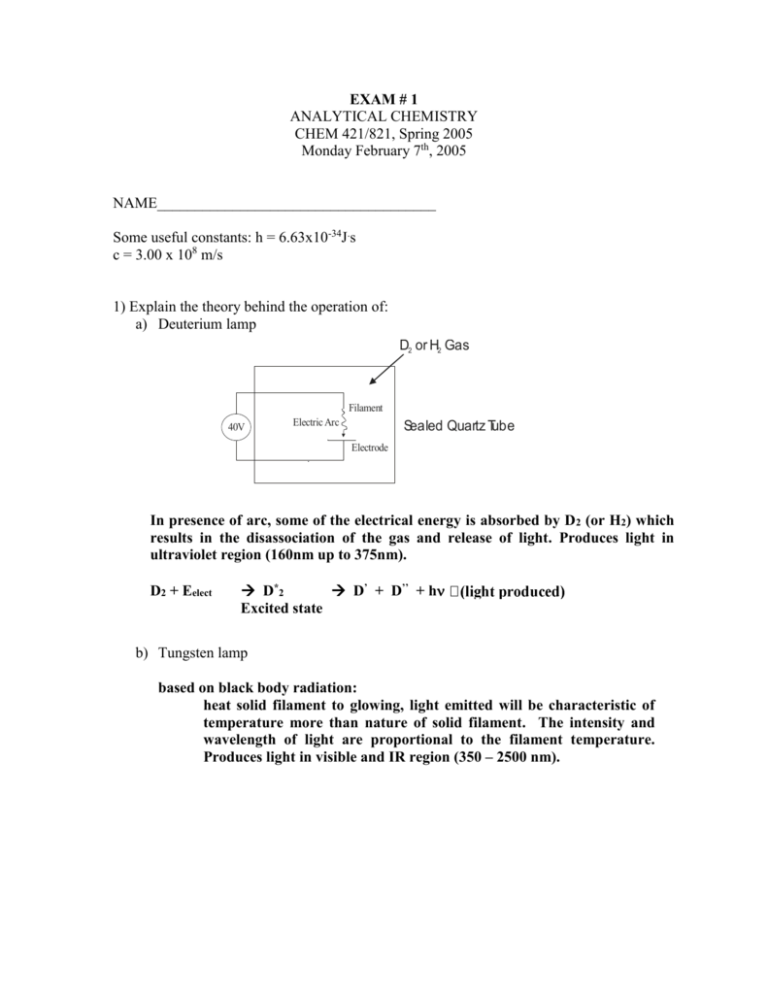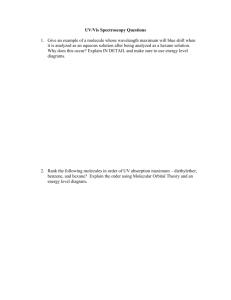EXAM # 1
advertisement

EXAM # 1 ANALYTICAL CHEMISTRY CHEM 421/821, Spring 2005 Monday February 7th, 2005 NAME_____________________________________ Some useful constants: h = 6.63x10-34J.s c = 3.00 x 108 m/s 1) Explain the theory behind the operation of: a) Deuterium lamp D2 or H2 Gas Filament 40V Electric Arc Sealed Quartz Tube Electrode In presence of arc, some of the electrical energy is absorbed by D 2 (or H2) which results in the disassociation of the gas and release of light. Produces light in ultraviolet region (160nm up to 375nm). D2 + Eelect D*2 D’ + D’’ + h Excited state b) Tungsten lamp based on black body radiation: heat solid filament to glowing, light emitted will be characteristic of temperature more than nature of solid filament. The intensity and wavelength of light are proportional to the filament temperature. Produces light in visible and IR region (350 – 2500 nm). 2) Explain the theory behind the operation of: c) Photomultiplier tube detector A series of nine dynodes (cathodes) where each dynode is covered with a photoemissive material (Cs2O) and a 90V potential is applied between each dynode. When light hits cathode, an electron is emitted and attracted to dynode #1. This collision causes more electrons to be emitted and attracted towards dynode #2. Process continues until e- are collected at anode after amplification at 9 dynodes. One photon produces 106 – 107 electrons. Very sensitive to low light sensitive, but needs large external power supply (900V). PMT is easily damaged by intense light. d) Silicon Diode or Photodiode detector Light is converted to an electrical current by taking advantage of the property of semiconducting material that conducts current only under certain conditions. A semiconductor contains a stable p region (electron holes) and an n region (additional electrons). The electrons are impeded from traveling from the n region towards the p region by the repulsion of the p-region acceptor atoms. A photon of light provides enough energy to overcome this barrier and allow electrons to flow and generate a current. The observed current is proportional to the intensity of light. Not very sensitive, but can place multiple silicon diodes in a 1D or 2D array to measure positional changes in absorption. 3) Why is systematic error more difficult to detect than random error? Systematic error is a constant deviation from the true or accepted value. Thus, to identify a systematic error, some knowledge of the true value is necessary. This requires obtaining a calibration curve against known standards. Conversely, random error is a fluctuation about the true value and can simply be determined by the variability in a set of repeated data points (standard deviation). 4) The results of a general chemistry acid/base titration laboratory for 24 students indicated an average concentration of 0.1674M for the “unknown” with a standard deviation of ±0.2591M. The lab assistant had weighed out the sample such that the unknown had a concentration of 0.1M. What do these results tell us about the accuracy and precision of the students’ measurements? Explain The student data is accurate with low precision. The observed average of 0.1674M is equivalent to 0.1M within the reported error of the experiment, 0.1M falls within 0.1674 ± 0.2591M. The precision is low since the standard deviation is in the same range (actually larger) than the reported average value. Conversely, a high precision would be consistent with: 0.1674 ± 0.0047 M, but in this case the accuracy would be low since the difference is now significantly greater than the experimental error. 5) What is the difference between limits of detection and sensitivity? Both terms are directly related to the calibration curve. The sensitivity is the slope of the calibration curve. Limits of Detection is the observable minimum analyte signal which is determined by the ratio of the mean blank signal divided by the slope of the calibration curve. Typically, a minimum S/N ratio of 2 is required for the reliable detection of a true signal from a sample. 6) An echellette grating that contains 1500 blazes/mm is used in a UV/vis spectrometer where the incident angle of the polychromatic beam is 10o. (a) At what angle from the grating would you be able to observe light with a wavelength of 260nm? n = d(sin + sin ) d = 1 mm/1500 blazes x 106nm/mm = 666.67 nm/blaze 260nm = 666.67nm(sin r + sin 10) sin r = 260nm/666.67nm - sin 10 sin r = 0.216 r = sin-1 0.216 = 125o (b) Is this visible or ultraviolet light? Ultraviolet light (c) What is the energy of a photon of this light? E = h = hc/6.63x10-34J.s x 3.00 x 108 m/s) / (260nm x 10-9nm/m) = 1.989x10-25 J.m / 2.6x10-7 m = 7.65 x 10-19 J (d) If an analyte exhibited a percent transmission of 60% at 260nm, what is its absorbance? A = -log(%T/100) A = -log(60%/100) A = -log(0.6) = 0.222 7) Given the following calibration curve, explain possible sources of deviation from linearity. - Stray Light - Polychromatic light (more then a single ) may be different for each - Molar absorptivity change in solutions more concentrated than 0.01M (molecular interaction) - association, dissociation, precipitation or reaction of analyte - instrument noise - 0% T noise, shot noise, flicker noise, readout precision, cell position 8) A methodology was developed to simultaneously determine the amount of cobalt and nickel present in a sample based upon their respective 8-hydroxyquinolinol complex formation. Given the following molar absorptivities corresponding to their absorption maxima: Molar Absorptivity (L cm-1 mol -1) at: 365 nm 700 nm Co 3529 428.9 Ni 3228 0.00 Calculate the concentration of nickel and cobalt based on the following data: A365 = 0.537, A700 = 0.044 in a cell with a 1.00 cm path length. A = bc A365 =A365Co + A365Ni = 365CobcCo + 365NibcNi A365 = 0.537 = 3529 x 1.00 x cCo + 3228 x 1.00 x cNi 0.537 = 3529xcCo + 3228xcNi A700 =A700Co + A700Ni = 700CobcCo + 700NibcNi A700 = 0.044 = 428.9 x 1.00 x cCo + 0.00 x 1.00 x cNi 0.044 = 428.9xcCo cCo = 0.044/428.9 = 1.03x10-4 M Substituting back into the first equation: 0.537 = 3529xcCo + 3228xcNi 0.537 = 3529x1.03x10-4M + 3228xcNi cNi = (0.537 – 0.3621)/3228 = 5.42x10-5 M 9) Compare the theories that describe the mechanism of UV/vis absorption and fluorescence (use energy level diagrams). Both UV/vis and fluorescenc requires the absorption of a photon of light by a bonding electron to generate an excited state. These transisitons are typically to * or n to *,*. For fluorescence, the absorbance of light results in an electron being promoted from a ground singlet state to an excited singlet state. The electrons remain paired (opposite spin). The main difference between the two processes is the method of relaxation. In UV/vis absorption, the bonding electron relaxes rapidly (10-8-10-9 s) by the dissipation of heat to the solvent. The relaxation in fluorescence occurs slower than UV/vis (10-5 to 10-8 s) and through the re-emission of light that is typically at a higher wavelength (), lower energy. 10) Draw a compound that you would predict to be (a) UV/vis active but not fluorescent, (b) fluorescent, and (c) both UV/vis and fluorescent inactive. Explain. (a) any compound with a double bond (-* transitions): O CH3CCH3 (b) any fused aromatic ring system (fluorescence favored for rigid structures): (c) any compound that lacks double bond, aromatic, or non-bonded characteristics, typically solvents for UV/vis spectroscopy (opposite above). Water, ethanol, n-heptane, etc


